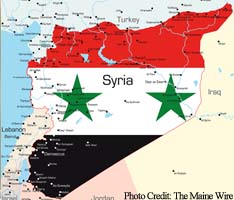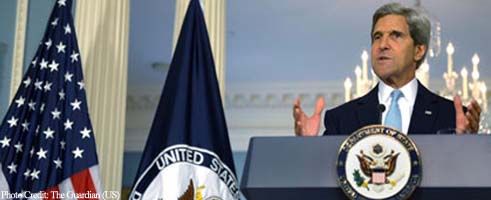When I was in college, we used to talk a lot about “the binary.” I don’t know if it is still in use in the common lexicon—but think it is still associated with things we talk about a lot with respect to gender identification and other social identities. We disavow a binary construction of gender, culture, and race, and we recognize that either/or descriptions don’t fit or do service to any human being. We see a spectrum, a range of positions of what is possible, each based on the individual qualities and multiple factors that inform and reflect who we are—we recognize intersectionality. In the dominant discourse however, in politics and elsewhere, ‘binary” constructions are still the norm.
I have been thinking about this concept with respect to U.S military response in Syria. Regardless of my confusion as to what to think about the Obama administration’s oscillation on the subject, I was once again stuck by the “binary” choice that was initially laid out for us as it most often is with respect to military intervention and lack thereof. While there is in fact a “spectrum” of options; as we now know as Obama did go to congress to glean their approval after initially proposing a unilateral executive order for military intervention; the initial rhetoric was the familiar “either /or.” Kerry, after laying out the context in Syria, said:
And make no mistake, in an increasingly complicated world of sectarian and religious extremist violence, what we choose to do or not do matters in real ways to our security. Some cite the risks of doing things, but we need to ask, what is the risk of doing nothing?”
Kerry was using as his reference point the all too familiar violence/ reframing from violence binary here– fight or flight– and this is the paradigm we are all most familiar with. Another form of “flight” is to “freeze”—which seems to be describing Kerry’s view of what we are doing if we don’t use military action. In politics, a binary construction of decision making is still the pervasive construct.
We are still talking about binaries in college now, their origins in the parts of enlightenment rationalism that have failed us, and the ways this generation is called to stretch , deconstruct, and configure what they have defined, right? Contemplative Practices (meditation, prayer, spiritual practices, even writing and various art forms) and much of what is taught in the liberal arts curriculum itself exists to help us learn to think and feel beyond a binary construction. Fight or flight exists deep in us, in our physiology. But so does the capacity to move beyond the physiology to the imagination—that is part of what it means to be human. And to be educated means to always look deeply in to what is before you, to never except at the truth exactly as it has been presented by the mainstream.
So let’s look at the dominant voices when it comes to war and peace. The US talks about security and freedom. But being constrained by an ideological binary in which military action/ inaction are the only options can never bring true freedom, can it? Aren’t political and ideological pluralism part of living in a liberal democracy, and isn’t the heart of a liberal democracy putting human rights at the center of all discourse? Thus striking that our secretary of state can speak as if to not strike Syrian is to “do nothing.”
In the words of Adrienne Rich, “War is an absolute failure of imagination.” It is imagination that moves us beyond what is most primitive, beyond our “fight or flight” impulses. It is our imagination that allows us to have empathy and think outside the boxes that have been created for us, with respect to things like social and cultural identity. Let’s use it to explore the urgent question of war and global violence, let’s see how wide and vast and rich and multifaceted the space between fight and flight might be.
Author: Matilda Cantwell


